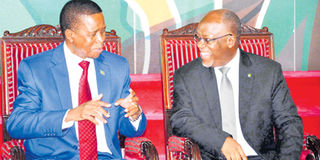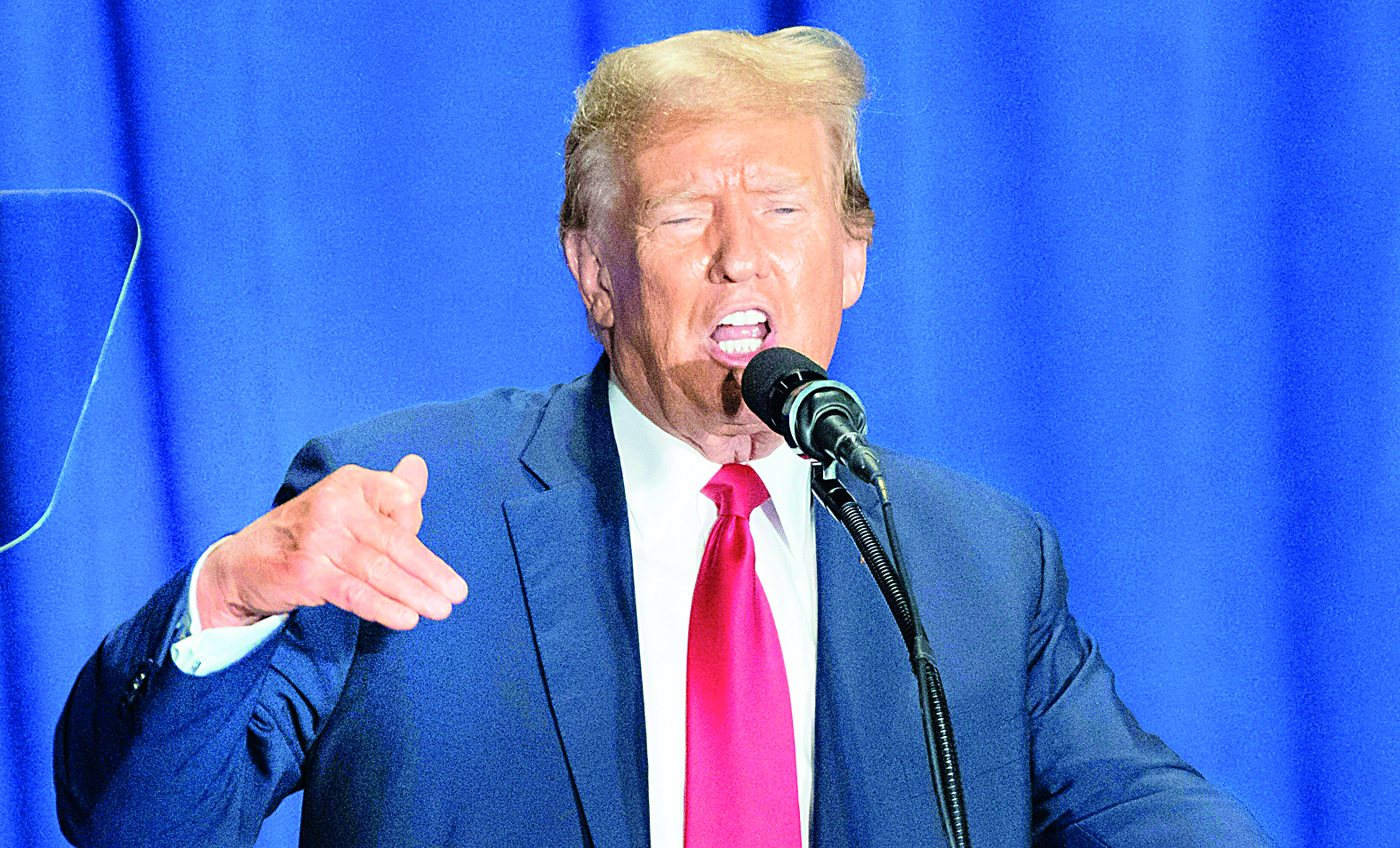Dar-Lusaka ties: New bid to keep train on the rails

The building of a partnership: The 1,860-km Tazara railway line from Dar es Salaam to Kapiri Mposhi during its construction. Presidents John Magufuli and Edgar Lungu agreed Monday to fix the rot at Tazara, a joint project that has been a symbol of “friendship”. PHOTO | FILE
What you need to know:
The mediocre performance of the Tanzania-Zambia Railway Authority (Tazara) project naturally topped the agenda of the three-day state visit by Zambian President Edgar Lungu who arrived in Dar es Salaam on Sunday.
Dar es Salaam. From Dar es Salaam to Kapiri Mposhi in Zambia, the rusty railway line that meanders over 1,860km is the most striking symbol of the age-old political and economic relations between Tanzania, its neighbour to the south and the Chinese. Yet years of gross mismanagement have perennially haunted what arguably could by now be one of the most successful joint infrastructure projects in east and southern Africa.
The mediocre performance of the Tanzania-Zambia Railway Authority (Tazara) project naturally topped the agenda of the three-day state visit by Zambian President Edgar Lungu who arrived in Dar es Salaam on Sunday.
Addressing the media after a closed-door meeting with his host on Monday, Mr Lungu said there was need for a new thinking to revamp the multi-million dollar project that has been the backbone of the bilateral ties between Tanzania and his country.
Both the Zambian leader and President John Magufuli took a swipe at poor management, largely blaming it for the stunted growth of Tazara, a baby born out of protest against the apartheid regime in South Africa.
The railway line was built by the Chinese government in the early 1970s at the height of Zambia’s support for the liberation struggle in Southern Africa as a new export route for the country.
Protesting against the racist whites in South Africa and the hostile white settler regime in neighbouring Rhodesia (now Zimbabwe), Zambia’s founding leader Kenneth Kaunda struck a deal with Julius Nyerere for an aternative passage to bring in goods and take out others to the outside markets.
The plan was to build the 1,860-km railway track from Dar es Salaam to Kapiri Mposhi. That deal was the beginning of a new era for Zambia-Tanzania relations.
“To date, Tazara, also fondly known as the ‘Great Uhuru Railway’ because of the role it played in the liberation of many countries in Southern Africa, is the greatest symbol of friendship between the nations of China, Tanzania and Zambia,” the authority notes on its website.
“Tazara provides a platform for political and socio-economic relationships amongst the three countries, which relationships brought about the existence of the railway line in the first place.”
But since that deal was struck over three decades ago, the journey has been rough and rugged.
Tazara has had a mixed fortune – for years hailed as a successful and “critical uniting factor”, yet all the way piling up debts that by early this year reportedly got close to $800 million (Sh1.7 trillion) and threatening the continued existence of the only most visible, most tangible symbol of friendship between Tanzania and Zambia.
Save for the noise frequently made by frustrated unpaid railway workers, Tazara has suffered more in silence over the years (symptomatic of the quiet diplomacy that has sustained Dar-Lusaka relations).
But that did not take away the genuine fears it could derail and dampen the morale to boost ties between the two countries.
On Monday, it was the main focus of President Magufuli’s brief speech at State House, in which he brushed aside claims of under capitalisation saying the project has had adequate funding from the beginning – but lacked competent management.
While he also touched on the envisaged one-stop border post at Tunduma, promising that Tanzania would meet its end of the bargain by completing construction in the next 18 months, it was Tazara, the Dar-Lusaka problem-child, which formed the centre of his address.
A new deal agreed on by the two heads of state this week will now open the doors for a wider pool of potential contenders from the partner nations and beyond for Tazara’s top management posts – seen as a critical starting point in efforts to change its fortunes.
Dr Magufuli revealed that he had an agreement with his Zambian counterpart that the criterion for the post of managing director had to change as part of renewed efforts to fix the mess that has left Tazara reeling from its huge debt.
The deal paves the way for a new era. But will it undo the years of poor management that nearly brought Tazara down to its knees?
Mr Lungu told journalists that the new approach was motivated by the desire to make profit and do sustainable business – and not based on the political arrangement the two countries entered into when the railway line was built by the Chinese in the 1970s.
Under the old arrangement, the post of managing director was reserved for a Zambian while his deputy was Tanzanian.
In April this year, Tazara appointed Eng Bruno Tandeo Ching’andu, a former director of technical services with the Zambia Railways Limited, as the new boss.
He replaced another Zambian, Eng Ronald Phiri, who was appointed April 2013 in acting capacity for an interim period of three months, which however was extended to three years, as the shareholders sought a suitable candidate to replace him.
Before his appointment, the Tazara board of directors had announced their decision not to renew the contracts for both the then managing director Akashambatwa Mbikusita-Lewanika and his deputy, Dr Damas Ndumbaro, to pave the way for the engagement of “new leadership and new thinking”.
Presidents Magufuli and Lungu echoed the same sentiments Monday.
According to Mr Lungu, who praised the current Tazara management for overseeing a turnaround since heads rolled early this year, the future now looks bright.
His view is backdropped by a communique released last Friday, in which the board of directors revealed that in the first quarter of the 2016/2017 financial year, commencing July 2016 and ending on September 30th, Tazara had increased freight and passenger traffic by 9.4 and 20.2 per cent, respectively.
It noted: “The improvements recorded during the period under review were mostly attributed to continued interventions by the two-shareholding governments through the provision of working capital support, which facilitated an enabling business environment and stability in operations.”
But more needs to be done to keep the project running.
Tazara has since reached out to private investors for partnership.
“The private sector can take advantage of the Public-Private Partnership (PPP) models to partner with us in the running of the Dar es Salaam Commuter Train, whose demand is massive and cannot be satisfied at the moment,” he said.
“We are also open to PPPs in the installation of the signalling and telecommunication systems, which have been vandalised over the years and are currently non-existent.”
Early this year, senior government officials from Tanzania, China and Zambia met in Dar es Salaam where they rolled out an ambitious plan to revamp and extend the railway to four other countries.
The meeting recommended major renovations to the rusty narrow gauge railway line and approve of plans to link Tazara to the multibillion-dollar Bagamoyo port, as well as to Malawi, DR Congo, Rwanda and Burundi.
Mr Ching’andu said the plan to connect Tazara with the Bagamoyo port will allow major companies in Dar es Salaam to connect to the port to ease shipping of cargo.
Infrastructural deteriorations
A survey conducted between June and December 2012 a Chinese firm, Third Railway Survey and Design Institute Group (TSDI), concluded that Tazara’s operational failure included weaknesses in management.
“Failure to reach a consensus between different management levels may lead to poor decision-making,” said the research document presented at the meeting.
Back then, the Tazara debt was reported to be around $787 million.
Mr Ching’andu said Lusaka and Dar es Salaam had agreed in principle to absorb the bad debt in order to allow the joint railway line to resume on a clean slate.
A permanent secretary in the Ministry of Works, Transport and Communications was quoted in the media as saying experts suggested inviting the private sector into the Tazara business operations mix, where companies or individuals would be allowed to operate private wagons on government tracks.
“The government would own the railway infrastructure, but investors would be allowed to run private trains on the tracks for a fee,” he said.
This could see private train operators run transportation schedules on government tracks from as far away as South Africa to Dar es Salaam because the entire Sadc region is linked with the narrow Cape gauge tracks.
“With the current level of interactions and closer dealings with the various stakeholders, we are optimistic that Tazara’s huge potential to contribute to the economies of Tanzania and Zambia will be realised soon,” said Eng Ching’andu.




